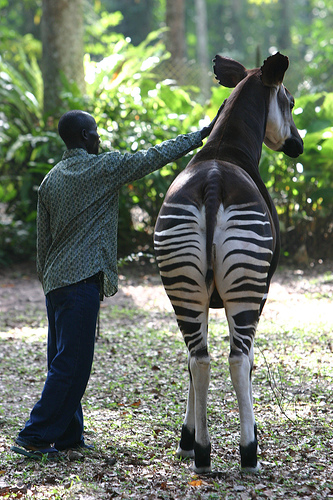Form and Function
The okapi are a four-legged mammal
that is closely related to the giraffe. Physically they look
strange compared to other animals in the area. Its body is a
brownish-red color from the legs up. Its legs are white with
black stripes, similar to that of a zebra. Normally the hairs on
the white stripes are longer than those on the dark stripes
(Quenqua, 2011). The hair on an okapi’s muzzle is black that
fades to white as it approaches the jawline and continues down
to the neck. Its coat is velvety and helps repel water (Quenqua,
2011).
Giraffes are the closest relative to
the okapi and these two have many similarities. Their backs are
both sloped so that their forequarters are elevated higher than
their rear and because of this the okapi must splay its legs to
the side in order to drink similarly to the giraffe. (Lindsey,
1956). The okapi and giraffe have even toed feet with glands
between them (Lindsey, 1956). However, unlike giraffes they have
three tarsal bones instead of four (Lindsey 1956). They also
have a shorter neck than giraffes but longer ones than most
other ruminants such as the
domestic cow and the
white-tailed deer.
Unlike many mammals the okapi does
not usually have 36 chromosomes. Although some do, the majority
of the okapi have 35 or even 34 chromosomes instead (Lindsey,
1956). This has been related to the Robertson fusion phenomenon
(Bodmer and Rabb, 1992). The Robertson fusion can result in two
things. One is that two centromeres fuse into one and the other
is when one centromere splits into two (Veith, 2009). In some
species this can cause mental problems such as down and patau
syndrome (Veith, 2009). This does not seem to cause and physical
or mental proble ms in the okapi though.
ms in the okapi though.
Some of the okapi’s senses are more
prominent than others. Their large ears and auditory bullae
enhance the okapi’s hearing. The auditory bullae is a large bony
capsule enclosing the middle ear bones (Lindsey, 1956). Despite
their large eyes, the okapi have a poor vision. The okapi’s
muzzle is narrow and strong to help with feeding. Okapi have 32
teeth with wrinkled enamel and a large gap between incisors and
premolars (Colbert, 1938). Similar to giraffes they have lobed
canine teeth. It also has a long dark blue tongue that can
stretch up to 25 cm (Dagg, 1960). This not only is a benefit for
feeding but also for cleanliness. They use their tongue to clean
both their eyes and ears.
Male and female okapi look similar
but have some physical differences. The average height of an
okapi is around 5 feet tall. Female okapi tend to be taller than
their male counterparts, usually by 2 inches. (Bodmer and Rabb,
1992). Both male and female okapi are about 2.5 meters (8 feet)
long (Bodmer and Rabb, 1992). Though the females are taller they
weigh significantly less than males. The average female weighs
between 55 and 100 pounds while the male okapi can be four times
heavier, ranging from 441 to 641 pounds (Bodmer and Rabb, 1992).
Another difference between male and female okapi is horns.
Female okapi lack horns but do have small bumps on their head
where the horns on male okapi are located (Bodmer an Rabb, 1992).
Horns on a male are covered with a thin layer of skin. The horns
can extend up to but no greater than 15 cm. 
The life expectancy of the okapi is
anywhere between 15 and 20 years for those who survive their
first year (Bodmer and Rabb, 1992). Infant okapi weigh 14-30 kg
at birth and are able to stand on their own only a half hour
after birth (Bodmer and Rabb, 1992). Their weight will
approximately double within the first month. They start
developing their horns after one year and reach adult size in
approximately 3 years (Lindsey, 1956). Sexual maturity is reached
earlier than this but it differs between males and females.
Females reach sexual maturity faster than males. They take about
1 year and 7 months where males take 2 years and 2 months to
reach sexual maturity (Bodmer and Rabb, 1992). Baby okapi do not
defecate during the first month of their life. This helps
prevent predators from picking up their scent (Quenqua, 2011).